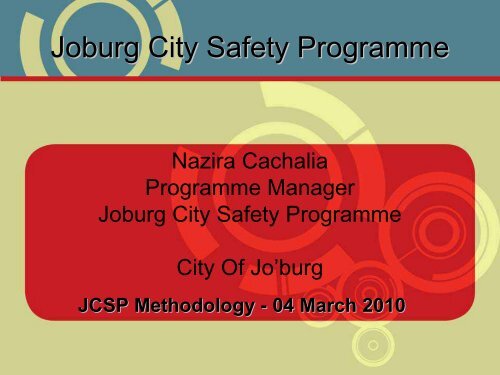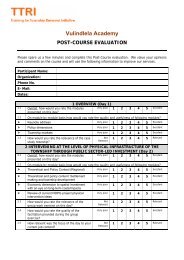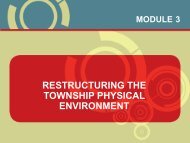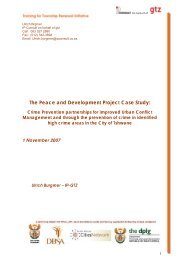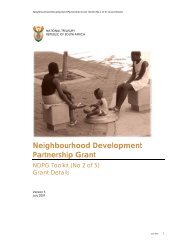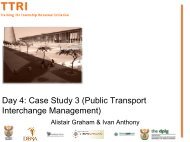Joburg City Safety Programme - NDP
Joburg City Safety Programme - NDP
Joburg City Safety Programme - NDP
- No tags were found...
You also want an ePaper? Increase the reach of your titles
YUMPU automatically turns print PDFs into web optimized ePapers that Google loves.
<strong>Joburg</strong> <strong>City</strong> <strong>Safety</strong> <strong>Programme</strong>Nazira Cachalia<strong>Programme</strong> Manager<strong>Joburg</strong> <strong>City</strong> <strong>Safety</strong> <strong>Programme</strong><strong>City</strong> Of Jo’burgJCSP Methodology - 04 March 2010
PART A• Overview of the <strong>Joburg</strong> <strong>City</strong> <strong>Safety</strong> <strong>Programme</strong>• Geographic Focus Area – Moroka – SowetoPART B• Tackling the Underlying Causes of Crime• Multi-disciplinary Approach• Priority Focus:- liquor outlets,- scrap metal dealers,- bad buildings1
The Jo'burg <strong>City</strong> <strong>Safety</strong> StrategyAn integrated, multi-disciplinary Jo'burg <strong>City</strong> <strong>Safety</strong> Strategy (JCSS) was approved by council in August2003. It defines a clear and logical approach to the <strong>City</strong>’s efforts to address crime in Johannesburg.It aims to:Contribute to thereduction of crimeImprove theperceptions ofsafety and reducethe fearof crimeThe JCSS proposes that there must be a holistic focus on law enforcement, crime prevention andimproved urban management and design to achieve sustainable urban security.The Jo'burg <strong>City</strong> <strong>Safety</strong> <strong>Programme</strong> (JCSP) was set up as the institutional mechanism to coordinatethe implementation of the JCSS in selected regions in the <strong>City</strong>.2
Achieving SustainableSolutions to Crime ReductionThe ‘TIPPING POINT’ is the critical point at which the accumulated effect of many interventionsby multiple role-players start to have a meaningful and sustained impact on crime and publicsafety.ImpactMeaningful & sustainedimpactTipping pointEffortIn order to reach this ‘tipping point’ the <strong>City</strong> of Johannesburg acknowledges that it is necessaryfor all relevant role-players in law enforcement and urban management to focus and coordinatetheir efforts in a coherent manner. This requires working together, using a common methodology,towards a shared vision.3
<strong>Programme</strong>componentsReduced crime and saferurban environmentPerceptionmanagementTackle theunderlyingcauses/aspects ofcrimeAddressing theneeds ofvulnerablegroupsLeverage visiblepolicing andsurveillancetechnologyOrderly city -ImprovedurbanmanagementSaferEnvironmentalDesign (CPTED)CommunicationLiquorYouthTargetedvisible patrolsCCTVExisting <strong>City</strong>infrastructureAll newdevelopmentsGunsWomenTrafficmanagementEffective by-lawenforcementMaintenance ofpublic spaceDrugsOrganisedcrimeImmigrantsHomelessStreettradingIllegal taxiranksBuildingsDumping /litteringParks &openspacesWastemanagementRoads,pavements &storm waterLightingMoral/ valuebreakdownTouristsIllegalconnectionsIllegal land /buildinginvasions
Example of the implementationof the JCSSRoad into area“Lite”accesscontrol“Lite”accesscontrolRoad into areaSecure Routes!BroadbandaccessVisible policingespecially ataccess points.Root outorganisedcrimeAccesscontrolPRIORITY AREARandom & ScheduledFirearm checks atentry & exit pointsAccesscontrolEnforceby-laws!Road into areaForfeit bad buildings.Replace with socialhousing and mixedhousing with buildingaccess control.Road into areaSecure Routes!Incentivise developmentof restaurants, shops,piazzas & ‘street culture’Develop sports &recreation centres,especially for the youthFIREARM CONTROL(‘Gun Free Zone’)AccesscontrolRoad into areaAccesscontrolKEY:CCTVCommunityPatrols“Lite”accesscontrol
MorokaGeographic Focus Area
• Location: : CoJ Region D, 25kms South West ofJohannesburg– The GFA is bound by Roodeport Rd. on the East;– on the South by old Potchefstroom Road;– on the West by Makapani Street which becomesMofokeng Street;– and on the North by the railway line.
• Composition:• Population:Estimated at 3,700,000• Land usage:• Schools:• Health Facilities: 5• Public Parks: 3• Transportation:Residential (houses, flats, and hostels)MorokaProfileCommercial (small to medium businesses petrolstations, bottle stores, general dealers, funeralparlours & car repair outfits. Informal businessessuch as cell phone outlets, tuck (house) shops, foodoutlets and second hand goods shops)60 Primary & 36 Secondary2 Train Stations, 07 Taxi Ranks, 01 BRT Station
Moroka GFA Team• Established in 2004• Multi Agency Team consists of key <strong>City</strong> role players andMoroka SAPS• Moroka Baseline Profile Developed• Moroka Master Plan Developed, updated in 2009• Monthly meetings held 1st Thursday of each month.• Successes to date: Joint Operations focusing on Liquor,Firearms, Drinking and Driving, Scrap Metal Dealers,Informal Trading, and Urban Management issues, andOverall reduction in contact crimes.• Liquor Traders Workshops• Awareness campaigns
Adopting a holistic approachAddress all underlying factors thatcreate an environment conducive tocrime•Crime “hot spots”•By-law infringement hot spots (illegalstreet trading, illegal dumping …)•Service delivery issues (long grass,street lighting …)•Other possible contributing factors toan unsafe environment (“bad”buildings, liquor outlets …)
Application• DiagnosticsCrime: RobberyTime: 18:00 – 02:00Days of week: Thursday to Saturday
Application• DiagnosticsLiquor outlet: The Rock
Application• Diagnostics• Prioritisation of issues• Planning– Interventions– Resource allocation• Monitoring• Evaluation• Knowledge management5 October 200512 November 2005
The JCSPMethodologyCreatebaselineProfileDevelopmaster planUpdateand revisemaster plan asrequiredDevelopmonthlyaction planImplementPlansMonitor andevaluate15
Role-playersROLE-PLAYERS INVOLVED IN IMPLEMENTATIONSA POLICE SERVICE• Province and station levelJOHANNESBURG METRO POLICEDEPARTMENTOTHER CENTRALDEPARTMENTS (COJ)•Emergency Management Services•Environment•Infrastructure and services•Housing•Community Development•Development Planning and Urban Management•Public Liaison (Communication)CITY REGIONS• Via the Urban Management UnitsJOHANNESBURG CITY SAFETY PROGRAMMEMUNICIPAL OWNED ENTITIES:•<strong>City</strong> Power•Johannesburg <strong>City</strong> Parks•Johannesburg Development Agency•Johannesburg Water•Johannesburg Roads Agency•PikitupPROVINCE:•Department of Community <strong>Safety</strong>•Department of Social Development•Gauteng Legislature•Gauteng Liquor Licensing UnitKEYKEYSTAKEHOLDERSSTAKEHOLDERS* Business * Community Policing Forums* Business * Community Policing Forums
Tackling the Underlying Causes of CrimeMulti-disciplinary ApproachPriority FocusPART B
Tackling the causes aswell as the symptoms• Many programmes have dealt with the ‘symptoms’ of the problems, buthave failed to deal with the underlying causes. They have therefore nothad sustainable results.• The JCSS makes recommendations about dealing with thesymptoms of the problems, but it also tries to tackle the causalfactors as a priority.• It is aimed at implementing solutions to reduce crime which aresustainable in the long-term, by dealing once and for all with the tricky,persistent underlying causes of some of the problems.
Multi-disciplinaryApproachThe power of joint operations•Multi-disciplinary operations involving role-players from a range ofagencies are a very effective way to tackle both the underlying causes andthe symptoms of many of the key problems.•They are particularly powerful if there is a good understanding of thelegislation (including Acts, by-laws etc) which empowers each differentagency, and of the way that legislation can be used. For example, wherethe SAPS is unable to close down a liquor outlet because it is generatingcrime in an area, the Department of Environmental Health may be able toclose it down because it is contravening numerous health and safety bylaws.•The JCSP recommends a common approach (with minor variations) totackling problematic businesses, including liquor outlets, second handgoods dealers, spray painters, panel beaters, ‘chop shops’ and other‘businesses’ in bad buildings. This approach is represented next…..
Multi-disciplinaryApproach
PriorityFocusLiquor OutletsTrade in Stolen GoodsBad Buildings
LiquorOutletsProblem Statement• Alcohol is major contributor to crimes such as:– Assault Common, Assault GBH, Rape, Domestic Violence,Robbery & Murder• These incidents of crimes are predominantly reported on– Fridays, Saturdays and Sundays• SA spends approximately R41 billion on alcohol per annum– 47% of murder victims tested positively for alcohol at the time ofdeath– 66% of people treated at casualty wards at hospitals were found to beunder the influence of alcohol– More than 50% of rape victims tested positive for were high or drunkat the time of the incident• The Moroka Precinct has 47 registered outlets, 70 shebeens, , and 21unlicensed Liquor Outlets
LiquorOutletsCausal Factors:•There are far too manyliquor outlets in closeproximity to each other andin inappropriate locations•Many of these outlets arenot compliant with healthand safety by-laws.•While some of these outletsare operating withoutpermits, many have beengranted permits by theGauteng Liquor LicensingUnit.•Where there are a largenumber of liquor outlets, thearea quickly deterioratesand crime increases.
LiquorOutletsSymptoms:• High incidence of violent social crimes• Increased incidence of driving under theinfluence of alcohol and related trafficaccidents• Poorly maintained, unclean andunattractive establishments• Poor lighting around establishments• Littering and waste accumulation aroundestablishments• Anti-social behaviour in and aroundplaces of entertainment• Illegal sales (e.g. serving alcohol tominors)• High volume noise levels• Prevalence of selling of recreational drugsand prostitution
LiquorOutletsDesired Outcomes and Response:• Close down all unlicensed liquor outlets• Close down all non-compliant liquor outlets• Reduce the number of licensed liquor outlets in close proximity to each otherCompile database of all businesses in the GFA where liquoris sold and / or consumed (including both licensed and unlicensed businesses)Develop a priority listing of liquor outlets that consistently contravene legislationand / or attract anti-social behaviour and criminal activities.Conduct regular multi agency inspections of Liquor Outlets to ensure complianceto Gauteng Liquor Act , CoJ Fire, Health, and Land usage by-laws ( to regulateprivate property usage).
Trade In StolenGoodsProblem Statement• There are various types of establishments that generate an income fromthe resale of stolen goods. These include:– Cell phone shops– Panel beaters and spray painters– Chop shops– Scrap metal dealers– Other second hand goods dealers• While the nature of these establishments vary, they share commonfeatures in that they provide an easy disposal point for stolen goods andoffer quick cash to sellers. They thus perpetuate and facilitate a range ofcriminal activities, including armed robbery and smash and grabs (oftenrelated to cell phones), housebreaking, carjacking, motor vehicle theft andthe theft of scrap metal.
Trade In StolenGoods
• Causal Factors:– Organised crime syndicates encourage the theft ofitems that can be resold through their network ofeasily accessible dealerships.– The availability of dealers who sell stolen goodsfacilitates casual and organised theft and robbery.• Symptoms:– Presence of numerous dealerships that do notcomply with the Second Hand Goods Act, the bylawsand other legislation– Interruption in or loss of basic services due to thetheft of non-ferrous metals– High number of incidents of armed robberies (incl.smash and grabs and carjacking), housebreakingand motor vehicle theft• Desired <strong>Programme</strong> Outcomes:– Prevent dealers from selling stolen goods– Close down the premises and confiscate propertyof dealers selling stolen goods or who consistentlydo not comply with the Second Hand Goods Act.Trade In StolenGoods
Trade In StolenGoodsResponse: Compile a database & GIS map of all businesses which are secondhand goods shops, cell phone shops, panel beaters, spray painters,chop shops & scrap metal dealers.Identify the dealerships which are believed to be selling stolen goodsfor priority focusTackle the causal factors: Gather as much info as possible aboutthese dealerships, their beneficiaries, owners, managers by meansof covert inspections & crime intelligence ops.Use the Second Hand Goods Act as a powerful way of closingunlicensed operations. Emphasise financial & asset confiscationmeasures, tax & the use of anti-racketeering legislationImplement ongoing multi-disciplinary operations to improvecompliance
BadBuildings• Problem Statement– Bad buildings have certain identifiablecharacteristics – they usually have largeoutstanding municipal utility bills and asa result have very poor or no services;– They are poorly maintained and are veryovercrowded; they pose major fire, healthand safety hazards and generate largeamounts of waste and ‘grime’ in the area.– Often used as hideouts or bases forcriminals, and they are major crimegenerators.– High crime levels in an area can be tracedback to a specific building
BadBuildings• Causal Factors:– The owners of the building (whether they are the actual owners or havehijacked the building via fraudulent means) do not pay rates and taxes, do notmaintain the building, allow sub-division and overcrowding and essentiallyfacilitate crime in and around the building.• Symptoms:– High crime levels in and around the building, including: Common Assault,Assault GBH, Intimidation, Rape, Arson, Aggravated Robbery and Murder.– Illegal connections– Poor maintenance– Waste and grime in and around building– Fire, health and safety hazards– Other illicit activities in and around the building – ‘chop shops’, unlicensed ornon-compliant liquor outlets, prostitution, sale of drugs and substance abuse.• Desired <strong>Programme</strong> Outcomes:– Reduce the number of bad buildings in the Inner <strong>City</strong>. (The precise targetneeds to be agreed with all stakeholders as part of the implementationplanning process).– Remove all person/s who are fraudulently representing themselves as theowners of buildings (i.e. the criminals who have hijacked buildings) in theInner <strong>City</strong>
BadBuildings
Example of the implementationof the JCSSRoad into area“Lite”accesscontrol“Lite”accesscontrolRoad into areaSecure Routes!BroadbandaccessVisible policingespecially ataccess points.Root outorganisedcrimeAccesscontrolPRIORITY AREARandom & ScheduledFirearm checks atentry & exit pointsAccesscontrolEnforceby-laws!Road into areaForfeit bad buildings.Replace with socialhousing and mixedhousing with buildingaccess control.Road into areaSecure Routes!Incentivise developmentof restaurants, shops,piazzas & ‘street culture’Develop sports &recreation centres,especially for the youthFIREARM CONTROL(‘Gun Free Zone’)AccesscontrolRoad into areaAccesscontrolKEY:CCTVCommunityPatrols“Lite”accesscontrol
WORKING TOGETHER FOR A SAFER JOBURG!THANK YOU


